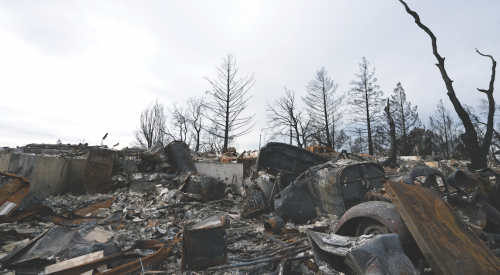Disaster Mitigation Strategies That Exceed Code Could Save Billions
Specific disaster mitigation strategies that go beyond the requirements of the 2015 International Codes model building codes could save the nation billions of dollars, according to the National Institute of Building Sciences just issued Natural Hazard Mitigation Saves: 2017 Interim Report.
Investing in hazard mitigation measures to exceed select code requirements can save the nation $4 for every $1 spent, the report says. The report comes on the heels of the nation’s worst year of natural disasters in terms of cost. There were 16 events in 2017 with losses exceeding $1 billion, with total costs of about $306 billion, surpassing the record losses in 2005 by $100 billion.
Effective strategies to exceed minimum requirements of the 2015 I-Codes include:
- For flood resistance (to address riverine flooding and hurricane surge), building new homes higher than required by the 2015 International Building Code (IBC).
- For resistance to hurricane winds, building new homes to comply with the Insurance Institute for Business & Home Safety (IBHS) FORTIFIED Home Hurricane standards.
- For resistance to earthquakes, building new buildings stronger and stiffer than required by the 2015 IBC.
- For fire resistance in the wildland-urban interface, building new buildings to comply with the 2015 International Wildland-Urban Interface Code (IWUIC).
NIBS notes that while mitigation represents an excellent investment, not everyone is willing or able to bear construction costs for more resilient buildings, even if the long-term benefits exceed the up-front costs. Programs to help finance mitigation projects should align incentives from finance, insurance, government and other stakeholders, NIBS says.
OSHA Penalties for Violations Increase
As of the first of the year, civil penalties for violations of OSHA standards and regulations were increased to adjust for inflation. In fact, the U.S. Department of Labor increased civil penalties for a variety of regulated areas, such as Immigration, Child Labor, Wage and Hour, MSHA, and OSHA.
The 2018 maximum OSHA penalties are:
- Other-than-Serious: $12,934
- Serious: $12,934
- Repeat : $129,336
- Willful: $129,336
The penalty increase applies to Federal OSHA regulations, but OSHA expects that states operating their own occupational safety and health program will align penalty structures with the federal agency.
Flying Drones While Drunk Made Illegal in New Jersey
Flying a drone after having too many drinks is now illegal in New Jersey. Governor Chris Christie signed a law this month that prohibits flying a drone with a blood alcohol content of 0.08% or higher, the same level as for driving a vehicle. Operating a drone while under the influence of drugs has also been banned.
Anybody caught violating the law faces up to six months in jail, a $1,000 fine, or both. The new law also bans flying a drone near a prison or in pursuit of wildlife.
At least 38 states are considering restrictions on drone flying this year, according to the National Conference of State Legislatures, a report by Reuters says. The Consumer Technology Association estimates that 3.1 million drones were sold in the U.S. last year, up 28% from 2016.
Mass. Zoning Reform Bill Would Override Local Rules to Encourage More Housing Development
A bill in the Massachusetts Legislature would revamp the state’s rules on zoning to encourage more housing development. The bill would set new statewide standards allowing for multifamily housing, accessory dwelling units, cluster zoning to preserve open space, and other smart growth initiatives.
It also eases the current statewide requirement of a super-majority vote to change local zoning or to grant special permits. It outlaws “exclusionary land use practices” that discriminate against racial or economic minorities, families, and other protected classes. Some 200 of the state’s 351 cities and towns haven’t built any new multifamily housing in the past 10 years, according to a column in the Boston Globe.
Extending PACE Financing Could Boost Natural Disaster Resilience and the Economy
Extending Property Assessed Clean Energy (PACE) financing to more states could boost the resiliency to natural disasters of the nation’s housing stock and stimulate the economy, says an article by the Rocky Mountain Institute (RMI). PACE allows the incremental cost of energy-efficient and hurricane-resilient reconstruction to be covered through financing secured by a special incremental property tax assessment.
Florida passed PACE legislation in 2010 and five programs are operating in the state. Two of those offer residential financing. Many Florida PACE programs finance hurricane protection improvements along with energy efficiency and renewable energy improvements. Texas, the other state hit hardest by hurricanes in 2017, on the other hand, does not have a well developed PACE program. RMI argues that PACE should be rolled out nationwide with provisions to finance natural disaster resilience.













